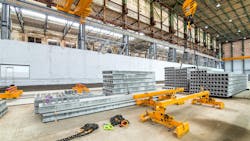AGC: Construction spending decreases in April
Construction spending fell for the third month in a row in April, declining 0.4% from March and 0.5% from a year earlier—the first year-over-year decrease since April 2019, according to a recent analysis of new government data by the Associated General Contractors of America.
Association officials warned that the decline in construction activity risks making the nation less competitive and will hurt economic growth.
“A pullback in many types of private nonresidential projects, as well as a sharp drop in homebuilding, contributed to the latest drop in construction spending,” Ken Simonson, AGC chief economist, said in a news release. “Ever-changing announcements about tariffs on key construction inputs, along with potential retaliatory measures by U.S. trading partners, are making owners hesitant to commit to new projects.”
Spending totaled $2.15 trillion at a seasonally adjusted annual rate in April, 0.4% below a downwardly revised March rate and 0.5% less than in April 2024. The decline followed decreases of 0.8% in March and 0.7% in February, AGC reported.
Private nonresidential construction shrank 0.5% for the month. The year-over-year increase of 1.0% was the smallest since July 2021. Spending on the largest private segment, manufacturing plants, slipped 0.6% in April. Private power construction spending fell 0.7%. Commercial construction—warehouse, retail, and farm projects—declined 1.0%.
Private residential construction slid 0.9% for the month and 4.8% from April 2024. Single-family homebuilding slumped 1.1% and spending on improvements to owner-occupied homes fell 0.8%. Multifamily construction inched down 0.1%.
Public construction increases softened the overall decline. Public spending climbed 0.4% from March and 5.5% from April 2024. Of the three largest public construction categories, highway and street construction rose 0.5% in April, spending on educational structures edged down 0.1%, and spending on transportation facilities rose 0.7%.
Association officials said the frequent changes in announced tariffs were making it difficult for owners and contractors to know what the cost of projects would be, while countermeasures by U.S. trading partners and a drop in foreign visitors were causing owners to postpone or cancel new projects. They urged the administration to avoid tariffs on key construction inputs such as steel, aluminum, and lumber.
“Unless contractors and investors have greater certainty about what costs and demand to expect, private construction is likely to continue declining,” AGC CEO Jeffrey D. Shoaf said. “That will make the U.S. less competitive and damage the prospects for economic growth.”
